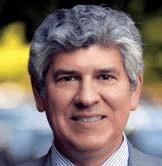What 13 Life Science Trendsetters Expect For 2017 And Beyond
By Rob Wright, Chief Editor, Life Science Leader
Follow Me On Twitter @RfwrightLSL
In an effort to prepare you to conquer the new year, Life Science Leader assembled some of our industry’s biggest trendsetters. We asked these thought leaders what they are expecting for 2017 and beyond. The sharing of this knowledge is meant not merely to provide you wisdom, but hopefully inspire insight.

WHAT U.S. TRENDS ARE GOING TO HAVE THE BIGGEST IMPACT ON BIOPHARMA IN 2017?
 Flemming Ornskov, M.D., M.P.H.
Flemming Ornskov, M.D., M.P.H.
CEO And Executive Committee Member, Shire
As an industry we need to do more to demonstrate the value of our medicines. One way we can do this is by appropriately leveraging technology. The ability of the biopharmaceutical industry to tap into the digital health revolution and forge effective collaborations with technology innovators for the benefit of patients will help determine our future success. Some ways in which technology partnerships will likely be useful include advanced therapies with specific disease targets, better diagnostics, “smart” devices for improved drug delivery, and disease management.
 Mark Alles
Mark Alles
CEO, Celgene
Concerns about access due to the cost of some newer therapies have created confusion and frustration, resulting in advocacy organizations challenging industry research efforts. Related to that issue is the trend toward improving understanding across stakeholder groups that patients with serious unmet medical needs are significantly benefiting from innovative therapies, thanks to the collaborative ecosystem between biopharmaceutical companies, payers, providers, government, and patient advocacy. Examples of collaborations include Vice President Biden’s Cancer Moonshot Program, the 21st Century Cures Act, and the FDA’s efforts to more rapidly approve innovative medicines and generic drugs. Biopharma will also be impacted by the demographic shift of aging populations in developed countries. Without medical breakthroughs to treat prevalent diseases of 50- to 70-year-olds, healthcare costs will continue to escalate.
 John Maraganore, Ph.D.
John Maraganore, Ph.D.
CEO And Board Of Director Member, Alnylam Pharmaceuticals
We can expect continued debate on drug pricing in 2017 and beyond. Importantly, I believe the industry will work with policy makers to find a path forward that preserves the time-limited and market-based reward for innovation. Perhaps the solution will be greater industry support of more rapid FDA review of ANDAs (abbreviated new drug applications), leading to greater competition in the generic market. After all, our “social contract” is to accept obsolescence for drug exclusivity in return for a defined period where innovation is rewarded. Price increases, in the absence of additional evidence to support value, are hard to defend. Companies will need to learn how to grow through innovation, not arbitrary price increases.
WHAT GLOBAL MACRO TRENDS ARE GOING TO HAVE THE BIGGEST IMPACT ON BIOPHARMA IN 2017?
 Christopher P. Austin, M.D.
Christopher P. Austin, M.D.
Director, National Center For Advancing Translational Sciences (NCATS), NIH
Engaging patients as members of the research team at all stages of translational science (i.e., early-stage research to postmarketing) is providing important insight that can be instrumental in making the development, testing, and deployment of new interventions more effective. Another trend will be the emergence or re-emergence of epidemic infections such as Zika and Ebola for which new therapies and vaccines will need to be rapidly developed. While gene-editing technologies such as CRISPR-Cas9 will continue to improve and be increasingly applied in advancing science and disease treatment, they also present complex technical challenges, as well as safety and ethical concerns.
 Jean-Jacques Bienaimé
Jean-Jacques Bienaimé
CEO And Chairman, BioMarin
While the voice of the patient has always been critical in the development of therapies for rare diseases, it will become increasingly more influential in all types of drug development. Look for more collaboration between drug developers, patients, and regulators to identify clinical end points that are scientifically meaningful and demonstrate improvement in patient quality of life. Patients are also articulating their tolerance for risk from treatments, particularly for fatal diseases, and their expectations for clinical efficacy. This level of intersection between patients, drug developers, and regulatory authorities has the potential to bring about more and better treatments.
 Vas Narasimhan, M.D.
Vas Narasimhan, M.D.
Global Head Of Drug Development And Chief Medical Officer, Novartis
Every year more than 36 million people are killed by chronic disease, a statistic projected to grow to over 70 percent by 2025. In addition to more people suffering from these diseases, chronic disease prevalence is increasing the economic burden of the already-rising healthcare costs around the world. Thus, I see the prevalence of chronic diseases as a major trend that will impact the biopharma industry as it strives to develop innovative treatments that improve standards of care.
WHAT TRENDS FROM OTHER INDUSTRIES WILL SPILL OVER INTO BIOPHARMA?
Alles: Big Data collection and analysis has transformed many other business sectors and is now a disruptive force in the healthcare and biopharmaceutical industries. The use of genomic and proteomic data with complex diseases (e.g., cancer) may allow for individualized treatment plans based on a patient’s molecular profile, rather than the histologic origin of their disease. Big data is helping researchers better analyze patient information, correlate and understand the results from thousands of published clinical trials, produce real-world evidence, identify new molecular targets, and design better clinical trials. Big Data, by matching patients with the best available treatments, should not only improve outcomes, but also lower healthcare costs.
Austin: The application of advanced computing and Big Data approaches has entered biomedical research. As a result of recent scientific advances, there is a tremendous amount of biomedical research data, disease classification data, health records, clinical trials, and adverse event reports. These could be useful for understanding health and disease, as well as for developing and identifying treatments. Advanced data-sharing and computational approaches are needed to collectively mine this data to gain insights into the relationship between molecular and cellular processes and the signs and symptoms manifested in diseases. A trend from the movie industry that is occurring increasingly in translational research is that of collaboration to maximize effectiveness and minimize risk. We will see increasing partnerships among government, academia, industry, and nonprofit patient organizations.
Bienaimé: We are seeing more competition in the rare disease space for assets to in-license, and more companies are going after the same diseases with different and novel scientific platforms in disease areas with established treatments. In this highly competitive environment, which, by the way, is great news for patients with rare diseases, drug developers need to set the bar high on meaningful clinical outcomes. At BioMarin, we pursue drug development in molecules that are the first or the best in their class. We believe this creates a win-win situation for patients and the companies developing the treatments.
 Stanley Crooke, M.D., Ph.D.
Stanley Crooke, M.D., Ph.D.
Founder, Chairman, CEO, Ionis Pharmaceuticals
The biopharmaceutical industry is clearly in the age of Big Data, beginning with genomics and other “omics” necessary for effective target selection. The ability to use the enormous amounts of information based on the natural history of human diseases, clinical trial data, and postmarketing data demands even more effective informatics.
 Ruud Dobber, Ph.D.
Ruud Dobber, Ph.D.
President AstraZeneca U.S., EVP AstraZeneca North America
Consumerism (i.e., patients driving their own care) is on the rise in healthcare. Technology advancements are allowing individuals to engage with their health in new ways and have the potential to improve quality of care, reduce costs, and increase the likelihood of patients reaching healthcare goals. While personalized medicine and services are the future of healthcare, success requires the industry moving from a fragmented way of engaging with patients to a coordinated experience similar to other customer-service industries. In an attempt to move in this direction, this year we launched AZHelps, a program that helps patients manage medication information, access savings offers, and access healthcare support through mobile devices and social media channels. We also have introduced Fit2Me, a free customizable cardiovascular and diabetes diet and lifestyle support program.
Maraganore: There appear to be many features of the film industry’s evolution over the last couple of decades that could serve as a template for the future of biopharma. Specifically, the disaggregation from large studios into smaller groups (e.g., Universal Pictures to Focus Features, Fox Searchlight to 20th Century Fox). One could imagine how a similar trend could occur in biopharma between smaller biotechs, larger pharma, specialty pharmacies, and other distribution channels. Of course, the economics would need to be rebalanced, since the only way a biotech can build value for its shareholders is to directly commercialize its products, at least in the major markets.
Narasimhan: Machine learning and artificial intelligence are having an increasingly tangible impact on the biopharma industry, which I see as a huge opportunity. Data is the key to the next generation of care, which will center on true precision medicine through more individualized and targeted treatment. Emerging technologies that enhance our data analytics capabilities by enabling us to process data and learn more efficiently will help us innovate faster. Having a more robust understanding of diseases and individual patient needs has the potential to alter the way we conduct drug development. Our goal is to leverage data insights to one day outsmart disease.
Ornskov: There are nearly 7,000 recognized rare diseases, yet 95 percent of these lack a single FDAapproved treatment. On average, proper diagnosis can take nearly five years. This is because physicians frequently do not recognize the signs and symptoms, and patients and caregivers often lack information. As part of Shire’s digital strategy, we are forming partnerships with rare disease online communities to help those diagnosed to become part of an extensive network to track and improve outcomes. By connecting with, and learning from, others who've gone before them, patients with rare diseases have the opportunity to more proactively manage their conditions, while researchers can learn more about what is and is not working and try to develop better treatments to fill those gaps.
 Michel Vounatsos
Michel Vounatsos
EVP And Chief Commercial Officer, Biogen
There is a lot we can learn from fast-moving consumer goods, particularly the way those companies contend with shorter life cycles and thinner margins and how doing so leads to their proactive management of resources. Consumer-focused companies also can teach us how to better engage with customers. While we work in an environment more regulated than most, we still need to get closer to patients and physicians and more effectively leverage digital and social media channels. For if we want to go beyond simply providing medicines, we need to engage in dialogue in the forums where these people increasingly turn.
HOW DO YOU THINK THE GLOBAL BIOPHARMACEUTICAL INDUSTRY MIGHT LOOK IN THE YEAR 2027?
Bienaimé: In a 2004 paper, geneticists Craig Venter and Daniel Cohen said that if the 20th century was the century of physics, the 21st will be the century of biology. We are living that prediction. Never before has there been so much hope in our ability to cure diseases. Scientific discoveries have improved the outcomes of many diseases (e.g., targeted cancer therapies, antiretroviral therapy for HIV/AIDS, and a cure for hepatitis C). In rare disease, the sequencing of the human genome opens a whole new area to help identify and explore treatments for monogenetic diseases. As there is more clarity on the science of diagnosing the more than 7,000 rare diseases, we will see more companies developing treatments. The 21st century could have more personalized treatments, better diagnostics, more regenerative-medicine cures, and hope for global access to life-changing therapies.
Crooke: By 2027, industry and the drugs it produces will look quite different. Every major company will need to participate in all three major platforms for drug discovery: small molecules, monoclonal, and RNAtargeted therapeutics. Gene therapy may be validated for the modest numbers of diseases that are due to single-gene deficiencies. As pricing pressure increases, the traditional follow-the-leader strategy (e.g., develop the 4th PCSK9 inhibitor) will no longer be available. So companies that are successful will take greater target risk, be more generically innovative, and probably have a narrower disease focus than in the past.
Dobber: I began my career in the lab. Early on, I learned how important it is to push the boundaries of science and look for answers, even when things seemed unexplainable. I think the next decade will be transformational in terms of the medical advancements we achieve. The opportunities we are uncovering using personalized approaches or with immunotherapy are remarkable. We are coming to a turning point in the way we think about treating disease. In the next 10 years, I want to see the industry raising the bar even higher on what science can do for patients and the word “cure” becoming a part of every diagnosis conversation — regardless of the medical condition.
Vounatsos: Over the next decade we will see therapeutic innovation across diseases of the central nervous system. But it won’t be enough to create breakthrough medicines. Because expectations are higher, industry will need to collaborate with physicians, patients, regulators, payers, and other key stakeholders in new ways. Diseases such as Alzheimer’s, ALS, and Parkinson’s exact a devastating toll on society and our healthcare system, and addressing these challenges will take more than the introduction of effective medicines.
WHAT TRENDS SHOULD BIOPHARMA EXECUTIVES BE PAYING CLOSEST ATTENTION TO?
 “The future in healthcare is about enabling whole-person care, not an individual pharmaceutical product. It’s about integrating that product into the delivery of care to drive better, more affordable care. I’ve worked in pharma, retail drug distribution, and healthcare services and have seen up close the disconnects that can occur. A less-fragmented healthcare system will allow all of us to proactively help individuals better manage their health and lower total medical costs, not just pharmacy costs. Taking a broad perspective and creating thoughtful partnerships is the place to start.”
“The future in healthcare is about enabling whole-person care, not an individual pharmaceutical product. It’s about integrating that product into the delivery of care to drive better, more affordable care. I’ve worked in pharma, retail drug distribution, and healthcare services and have seen up close the disconnects that can occur. A less-fragmented healthcare system will allow all of us to proactively help individuals better manage their health and lower total medical costs, not just pharmacy costs. Taking a broad perspective and creating thoughtful partnerships is the place to start.”
Jeffrey Berkowitz is EVP for the health-service company Optum. Prior to joining Optum, he spent six years at Walgreens overseeing the company’s enterprisewide strategic relationships with payers, pharma companies, and wholesalers.
WHAT TRENDS SHOULD BIOPHARMA EXECUTIVES BE PAYING CLOSEST ATTENTION TO?
 “Obviously, the future of pharmaceutical spending is of primary salience. Countries around the world are increasingly relying on health technology assessment and other formulary tools — such as reference pricing and budget caps — to pressure innovators. Traditionally, the United States has avoided such tools, but they are making substantial inroads here. While productspecific evidence of value is important, there is a paucity of policy work demonstrating, at the industry level, value to society and reforms to guarantee access in an era of rising costs. Life science leaders need to develop innovative treatments, but that will not always be enough. They also need innovative pricing mechanisms that ensure the developers are rewarded when patients tangibly do better. Leaders also need to do a more credible job demonstrating the direct link between R&D today and health tomorrow.”
“Obviously, the future of pharmaceutical spending is of primary salience. Countries around the world are increasingly relying on health technology assessment and other formulary tools — such as reference pricing and budget caps — to pressure innovators. Traditionally, the United States has avoided such tools, but they are making substantial inroads here. While productspecific evidence of value is important, there is a paucity of policy work demonstrating, at the industry level, value to society and reforms to guarantee access in an era of rising costs. Life science leaders need to develop innovative treatments, but that will not always be enough. They also need innovative pricing mechanisms that ensure the developers are rewarded when patients tangibly do better. Leaders also need to do a more credible job demonstrating the direct link between R&D today and health tomorrow.”
Dana Goldman is the Leonard D. Schaeffer Director’s Chair and distinguished professor of public policy, pharmacy, and economics at the University of Southern California.
WHAT TRENDS SHOULD BIOPHARMA EXECUTIVES BE PAYING CLOSEST ATTENTION TO?
 “Drug Pricing Transparency: The discrepancy between public perception and industry reality regarding drug pricing reached a fever pitch this past election season, reinforcing the increased importance of transparency — a key biopharma trend. Fostering an open, honest, and objective dialogue regarding innovation, investment, and public health benefit is vital to combat the irrational vilification of the industry and points to the real culprits, such as rising insurance co-pays, PBM (pharmacy benefit manager) rebates, and other nonbiopharma factors. Industry executives, therefore, need to educate the public, media, and policy influencers regarding the truth behind drug pricing, societal value, and corporate accountability.
“Drug Pricing Transparency: The discrepancy between public perception and industry reality regarding drug pricing reached a fever pitch this past election season, reinforcing the increased importance of transparency — a key biopharma trend. Fostering an open, honest, and objective dialogue regarding innovation, investment, and public health benefit is vital to combat the irrational vilification of the industry and points to the real culprits, such as rising insurance co-pays, PBM (pharmacy benefit manager) rebates, and other nonbiopharma factors. Industry executives, therefore, need to educate the public, media, and policy influencers regarding the truth behind drug pricing, societal value, and corporate accountability.
Off-Label Promotion: The surprising yet inexorable trend toward court-sanctioned off-label promotion is poised to transform how biopharmas communicate with healthcare professionals and potentially even patients and the public. The traditional ban on promoting drugs off label is being pitted against First Amendment rights, and the right to free speech appears to be winning out over FDA guidelines. Given the uncertainties and lack of formal guidance, however, biopharmaceutical companies should mitigate risk by closely following the court proceedings, remain current on the evolving FDA hearings and guidance, and strictly adhere to policy until advised otherwise.
Digitization of Commercialization: When it comes to bringing a drug to market, maximizing patent exclusivity has never been more important. Time is patent life, and more importantly, patient life, and the clock is ticking. Taking a molecule from a successful Phase 3 trial through NDA (new drug application) to commercial launch with speed and precision is critical to the long-term success of an in-market therapy, as well as to the patients whose lives depend on it. We have seen how biopharmas can struggle with transitioning from R&D into commercialized operations. However, some have begun successfully applying an array of digital technologies to evolve and execute faster in order to optimize their entire commercialization processes throughout the life cycle.”
Leerom Segal is a Canadian entrepreneur, humanitarian, philanthropist, and founding partner at Klick Health, one of the world’s largest independent health agencies and biotechnology commercialization partners.
WHAT TRENDS SHOULD BIOPHARMA EXECUTIVES BE PAYING CLOSEST ATTENTION TO?
 “Payers are looking more aggressively at strategies that reduce their drug spend. These efforts often involve restricting access to various therapeutic agents by creating prior authorization or other requirements, generally in accordance with clinical evidence as well as the cost/value of the drug. But payers are also employing other tactics such as offering more narrow formularies that are sold at a lower premium and offer a lesser choice of drugs than the base product. The past year also has seen a rise in interest in outcomes-based pharmaceutical agreements that more closely align payment and value to the patient. This approach, while it may be unfamiliar to pharmaceutical companies, is one that has been widely employed in agreements with provider systems; therefore expanding and modifying the framework to include drugs seems a natural evolution.
“Payers are looking more aggressively at strategies that reduce their drug spend. These efforts often involve restricting access to various therapeutic agents by creating prior authorization or other requirements, generally in accordance with clinical evidence as well as the cost/value of the drug. But payers are also employing other tactics such as offering more narrow formularies that are sold at a lower premium and offer a lesser choice of drugs than the base product. The past year also has seen a rise in interest in outcomes-based pharmaceutical agreements that more closely align payment and value to the patient. This approach, while it may be unfamiliar to pharmaceutical companies, is one that has been widely employed in agreements with provider systems; therefore expanding and modifying the framework to include drugs seems a natural evolution.
By aligning payment and value, these agreements not only send a strong message to those who question the missions of both pharmaceutical companies and health plans but also are considerations in the prescribing decisions of the many physicians and providers who themselves have entered into payment frameworks that reward quality outcomes versus volumes of encounters.”
Michael Sherman, M.D., MBA, M.S., is chief medical officer and senior VP for Harvard Pilgrim Health Care. He is also on the faculty of Harvard Medical School’s Department of Population Medicine.
